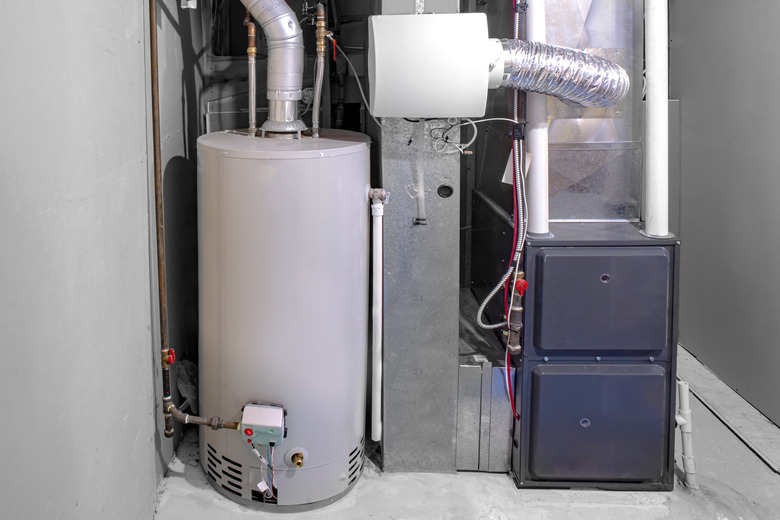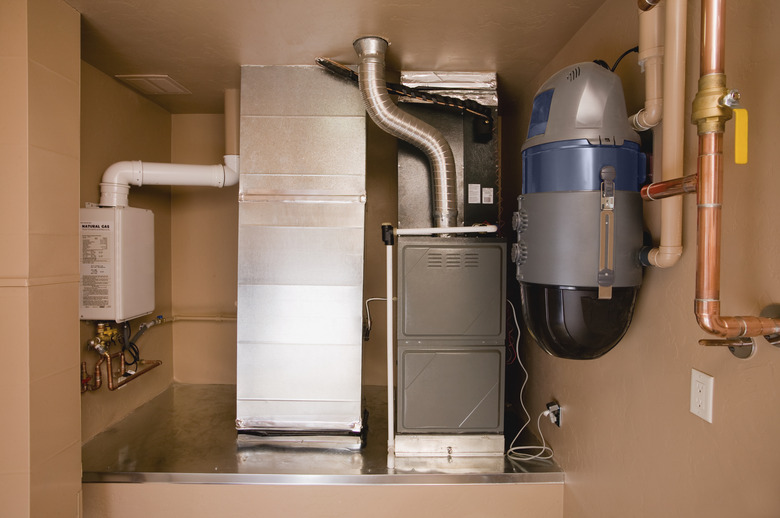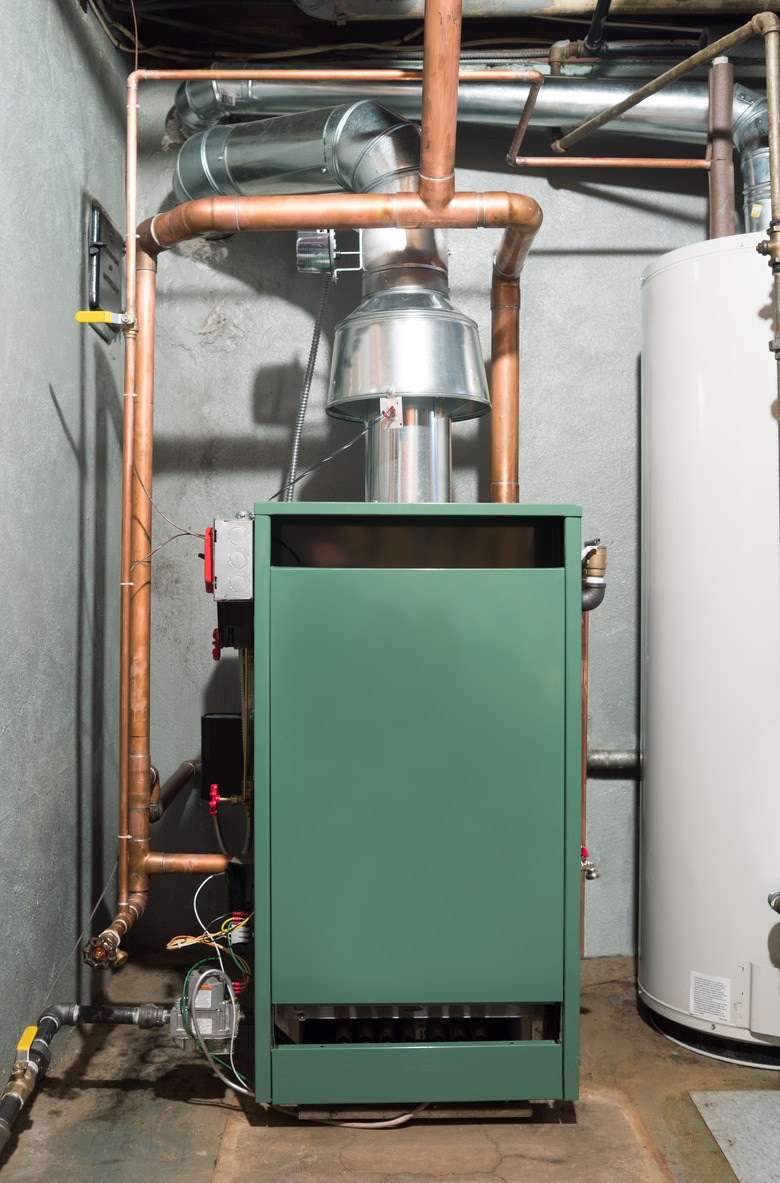How And Why To Clean Your Furnace Flame Sensor
We may receive a commission on purchases made from links.
It can be surprising and disconcerting when a small, seemingly innocuous part causes a whole system shutdown, and that's what happens when the flame sensor on a gas furnace is dirty or not working properly. The good news is that a furnace flame sensor is easy to find, remove and clean, and if you should happen to need a new one, replacements are inexpensive. There aren't that many HVAC jobs that homeowners with limited knowledge and experience can DIY, but this is one of them.
How do you know your gas furnace has a dirty flame sensor? The short answer is that the furnace doesn't work, which is problematic to say the least in the middle of a cold winter. More specifically, you'll probably hear the furnace's electronic ignition clicking, and the burner will come on for a few seconds, but it won't stay on. The clicking might repeat a few more times, but it will stop eventually. To prevent the buildup of unburned gas, the furnace will become unresponsive for an hour or so. To understand why this happens and what to do about it, it helps to know what a flame sensor does before you begin the cleaning process.
The Flame Sensor Senses Flames
The Flame Sensor Senses Flames
Some parts of an HVAC system have names like "damper" and "coil" that don't immediately give away their purpose, but that's not the case with a flame sensor. Its purpose is to sense a flame when the gas is on, and if it can't do that, it shuts off the gas. This is a safety measure that prevents the uncontrolled release of explosive gas and the fire and potential devastation that would happen if the gas were to ignite.
A flame sensor performs the same function as the thermocouple on a gas water heater with a standing pilot. A standing pilot is one that is always burning, and the job of a thermocouple is to shut off the gas if the pilot goes out. A gas furnace has an electronic igniter instead of a standing pilot, so it doesn't need a thermocouple. Instead, the flame sensor is positioned directly over the burner, and its job is to detect the burner flame.
The flame sensor does what it does by taking advantage of the Seebeck effect, a phenomenon by which two dissimilar metals develop a tiny electrical charge between them when each is subject to a different temperature. The sensor is a metallic rod that often has a 90-degree bend. The tip of the rod is made of one type of metal, and it sits inside the combustion chamber of the furnace. The base of the sensor is made of a different metal and is located just outside the combustion chamber. When a flame is burning, the temperature difference between the tip and the base generates a tiny electrical current (in the order of microamps), and this is carried to the gas valve by a wire connected to the base of the flame sensor.
Why Flame Sensors Go Bad
Why Flame Sensors Go Bad
Conditions inside the burner assembly can be gnarly. The high temperatures corrode the metal surface of the flame sensor, and carbon byproducts of combustion — basically soot — collect on the metal. Eventually, the combination of carbon buildup and corrosion essentially insulate the tip of the sensor from the heat, and it no longer generates the voltage to keep the gas valve open.
Flame sensors can also simply break. The base is coated with a porcelain cover to electrically insulate it from the metal parts of the burner, and this can crack or work itself loose. This breaks the electrical connection in the rod, creating an open circuit and rendering the sensor useless. When the flame sensor is damaged in this way or the metallic rod is corroded, it has to be replaced, but if the rod is just covered with carbon buildup, cleaning it should restore normal operation of the furnace.
Where to Find the Flame Sensor
Where to Find the Flame Sensor
The flame sensor is inserted through a hole in the cover of the furnace's combustion chamber at the end opposite the gas inlet pipe. When you remove the cover of the furnace, the oval or rectangular combustion chamber is right in front of you. Follow the gas pipe as it runs along the bottom of the burner and note the point at which it connects to the burner. Then, look at the opposite end of the combustion chamber and you'll see the flame sensor.
You're looking for a small, metal rod with a base covered in white porcelain, although the white color may have turned a dingy yellow. It's typically mounted to the burner housing by a single screw, and it has a single wire coming from it. The wire is connected to the terminal on the rod by a spade connector, which you can disconnect by simply pulling it off.
Things Needed
-
400-grit sandpaper or fine steel wool
How to Clean a Flame Sensor
How to Clean a Flame Sensor
The flame sensor could be causing your furnace problems, or it could be something else, such as a faulty gas valve or control board. You can test the flame sensor, but it's just as easy to clean it, and if the problems were due to the fact that it was dirty, your job is done. If cleaning the flame sensor doesn't restore normal operation, test it after you've cleaned it using a multimeter.
Warning
Perform this cleaning task in a well-ventilated area to avoid breathing in harmful chemicals.
1. Turn Off the Power
You definitely don't want the furnace to cycle on when you're working to avoid injury, so turn off the furnace disconnect switch (it's usually in a small electrical box mounted to the side or near the furnace). If you can't find a switch, go to the breaker box and turn off the circuit breaker controlling the furnace. After you're sure the power is off, locate the gas shutoff valve and turn it off.
2. Remove the Flame Sensor
Remove the cover over the combustion chamber. Locate the flame sensor and pull the electrical connector off the end. Unscrew the single screw holding the sensor to the burner housing using a Phillips screwdriver or a socket wrench depending on which type of screw head it has. Lift the sensor out of the burner and remove it. Then, put the screw in a safe place. You don't want to lose it.
3. Sand Off the Carbon Buildup
Sand the metallic rod of the flame sensor with 400-grit sandpaper or fine steel wool. Be gentle. The goal is to remove enough of the carbon deposits to expose the metal, which should begin to shine as you progress, but you don't want to etch the metal or sand through it, and you definitely don't want to exert enough pressure to bend the rod. If that happens, the sensor may not extend far enough into the flame to do its job, and you might have to replace it.
4. Wipe the Rod With a Solvent
Using a paper towel or fine steel wool, wipe down the metallic rod with a strong solvent, such as acetone or lacquer thinner. Keep rubbing until no more black residue rubs off onto the cloth or towel. When you're done, the rod should be shiny. Wear a respirator and provide plenty of ventilation while using these solvents. Keep them away from lighters and other open flame sources.
5. Replace the Sensor
Position the sensor in its place on the burner housing, ensuring the end of the rod is sticking as far into the flame as it was when you removed it. Then, reinstall the screw. Be sure this screw is tight because the vibrations from the blower could back it out if it's loose, and this could cause the tip of the sensor to fall out of the flame. Clip the electrical connector back onto the base of the rod.
6. Restart the Furnace
Turn the breaker or switch back on, open the gas valve and set the thermostat to a high temperature to get the furnace to kick on. If the blower comes on and the furnace starts, you're done. Reinstall the cover.
Testing the Flame Sensor
Testing the Flame Sensor
If the furnace doesn't work normally after cleaning the flame sensor, you might conclude that the flame sensor is faulty and decide to replace it — but wait ... not so fast. The problem could be something else, and if you order new parts online, you'll have to wait a week or more for them to arrive. That's a long time to go without your furnace, so to make sure that you aren't going on a wild goose chase, you should conduct another test on the flame sensor to make sure it's really the culprit.
To conduct this test, you need a sensitive multimeter with alligator clip leads that can measure current in microamperes (µA) and a helper who can power on the furnace by turning up the thermostat. Start by setting the meter to read current in µA, which is the most sensitive range. Disconnect the spade connector from the flame sensor and clip one of the leads to the base of the flame sensor and the other clip to the spade connector. Have your helper turn up the thermostat and then wait for the furnace ignitor to glow or begin sparking (depending on the type).
When the flame ignites, check the meter reading. If the flame sensor is good, you should see a reading between 0.5 and 10 µA. If you don't get a reading at all, the flame sensor is bad, and the flame will go out. If the flame doesn't ignite at all, something other than the flame sensor is at fault — possibly the control panel or gas valve. In this case, it's time to call in the pros because even if you think you know how to proceed, most local codes prohibit testing and servicing a gas valve without a license.
More Troubleshooting Tips
More Troubleshooting Tips
Sometimes, all it takes is a quick look at the flame sensor to determine that it needs to be replaced because cracked porcelain at the base or missing pieces are instant giveaways. You can also often verify visually that the device isn't properly mounted with its tip directly in the flame. The cause of the furnace malfunction could be something as simple and easy to fix as a loose mounting screw or a bad contact. If you do decide to remove the flame sensor and clean it, it's always a good idea to also clean the terminal at the base by rubbing it down with acetone or lacquer thinner.
To prevent problems in the future, it's a good idea to have the furnace tuned up once a year to make sure everything — particularly the flame sensor — is in good working order. The sensor is much easier to clean when it has only a thin coating of carbon deposits than when it has a thick coating that stops it from working. Most homeowners lack the time or inclination to do this themselves and are better off calling an HVAC technician to perform a routine checkup, which would include cleaning or replacing the filters, cleaning the blower and the blower motor and servicing the gas valve.


